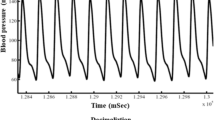Abstract
Baroreceptor sensitivity (BRS) is increasingly used as a prognostic indicator in cardiovascular disease. Traditionally it has been measured using invasive techniques with pharmacological manipulation of blood pressure (BP). With the advent of newer methods to measure pulse interval and beat-to-beat changes in BP it is now possible, using sophisticated mathematical modelling techniques, to calculate cardiac BRS non-invasively. However, there are virtually no data on the reproducibility of these newer techniques and what factors may affect the repeatability of these measurements. We studied 39 subjects, aged 22–82 years, with a supine systolic BP range 97–160 mmHg and a diastolic BP range 57–94 mmHg on two occasions between 1 week and 6 months apart. Cardiac BRS was measured by power spectral analysis using Fast Fourier Transformation (FFT), sequence analysis (using up, down and combined sequences) and from phase IV of the Valsalva manoeuvre. There was no significant difference between visits for any of the methods for measuring cardiac BRS. Mean BRS values were similar for FFT (16.7±11.2 ms/mmHg) and sequence analysis (15.8±11.4 ms/mmHg); however, results using phase IV of the Valsalva manoeuvre were significantly lower (8.1±2.9 ms/mmHg,p<0.0001). The coefficient of variation for the five measures of cardiac BRS varied from 16.8% for Valsalva-derived values to 26.1% for ‘down’ sequence analysis. However, in ten subjects BRS could not be calculated from the Valsalva manoeuvre. None of the independent variables tested (including age, BP levels and time between testing) significantly influenced the degree of repeatability. In summary, there appears to be little difference between these non-invasive methods in their degree of reproducibility. These techniques would seem suitable for longitudinal studies of changes in cardiac BRS and overcome many of the problems associated with the invasive pharmacological methods.
Similar content being viewed by others
References
Farrell TG, Odemuyiwa O, Bashir Y et al. Prognostic value of baroreflex sensitivity testing after acute myocardial infarction.Br Heart J 1992;67: 129–137.
Smyth HS, Sleight P, Pickering GW. Reflex regulation of arterial pressure during sleep in man: a quantitative method of assessing baroreflex sensitivity.Circ Res 1969;24: 109–121.
Gribbin B, Pickering TG, Sleight P, Peto R. Effect of age and high blood pressure on baroreflex sensitivity in man.Circ Res 1971;29: 424–431.
Smith SA, Stallard TJ, Salih MM, Littler WA. Can sinoaortic baroreceptor heart reflex sensitivity be determined from phase IV of the Valsalva manoeuvre?Cardiovasc Res 1987;21: 422–427.
Palmero HA, Caeiro TF, Iosa DJ, Bas J. Baroreceptor reflex sensitivity index derived from Phase IV of the Valsalva manoeuvre.Hypertension 1981;3 (Suppl. II): 134–137.
Eckberg DL, Convertino VA, Fritsch JM, Doerr DF. Reproducibility of human vagal carotid baroreceptor-cardiac reflex responses.Am J Physiol 1992;263: R215-R220.
Imholz BPM, Van Montfrans GA, Settels JJ, Van der Hoeven GMA, Karemaker JM, Wieling W. Continuous non-invasive blood pressure monitoring: reliability of Finapres device durign the Valsalva manoeuvre.Cardiovasc Res 1988;22: 390–397.
Lal SKL, Henderson RJ, Cejnar M Hart MG, Hunyor SN. Physiological influences on continuous finger and simultaneous intra-arterial blood pressure.Hypertension 1995;26: 307–314.
Stokes DN, Clutton-Brock T, Patil C, Thompson JM, Hutton P. Comparison of invasive and non-invasive measurement of continuous arterial pressure using the Finapres.Br J Anaesthesia 1991;67: 26–35.
Panerai RB, James MA, Potter JF, Fan L, Evans DH. Baroreceptor sensitivity in human subjects: sequence or spectral analysis.Computers in Cardiology 1995; 305–308.
Malliani A, Pagani M, Lombardi F, Cerutti S. Cardiovascular neural regulation explored in the frequency domain.Circulation 1991;84: 482–491.
Parati G, Saul JP, Di Rienzo M, Mancia G. Spectral analysis of blood pressure and heart rate variability in evaluating cardiovascular regulation. A critical appraisal.Hypertension 1995;25: 1276–1286.
Smith SA, Stallard TJ, Littler WA. Estimation of sinoaortic baroreceptor heart rate reflex sensitivity and latency in man: a new microcomputer assisted method of analysis.Cardiovasc Res 1986;20: 877–882.
Hartikainen JEK, Tahvanainen KUO, Mantysaari MJ, Tikkanen PE, Lansimies EA, Airaksinen KEJ. Simultaneous invasive and noninvasive evaluations of baroreflex sensitivity with bolus phenylephrine technique.Am Heart J 1995;130: 296–301.
Robbe HWJ, Mulder LJM, Ruddel H, Langewitz WA, Veldman JBP, Mulder G. Assessment of baroreceptor reflex sensitivity by means of spectral analysis.Hypertension 1987;10: 538–543.
Parlow J, Viale JP, Annat G, Hughson R, Quintin L. Spontaneous cardiac baroreflex in humans. Comparison with drug-induced responses.Hypertension 1995;25: 1058–1068.
James MA, Panerai RB, Potter JF. Spectral and sequence analysis in the assessment of arterial baroreflex sensitivity in the elderlyJ Hypertens 1996;12: 1499 (Abstract).
Iellamo F, Legramante JM, Raimondi G, Castrucci F, Massaro M, Peruzzi G. Evaluation of reproducibility of spontaneous barireflex sensitivity at rest and during laboratory tests.J Hypertens 1996;4: 1099–1104.
Parati G, Pomidossi G, Ramirez A, Cesana B, Mancia G. Variability of the haemodynamic responses to laboratory tests employed in assessment of neural cardiovascular regulation in man.Clin Sci 1985;69: 533–540.
Parati G, Pomidossi G, Ramierez A, Gavazzi C, Bertinieri G, Mancia G. Reproducibility of laboratory tests evaluating neural cardiovascular regulation in man.J Hypertens 1983;1 (Suppl. 2): 88–90.
Bland JM, Altman DG. Statistical methods for assessing agreement between two methods of clinical measurement.Lancet 1986;i: 307–310.
Trazzi S, Mutti E, Frattola A, Imholz B, Parati G, Mancia G. Reproducibility of non-invasive and intra-arterial blood pressure monitoring: implications for studies on antihypertensive treatment.J Hypertens 1991;9: 115–119.
Potter JF, Fotherby MD, MacDonald IA. Repeatability and relationship between arterialised catecholamines and blood pressure in elderly subjects.Age and Ageing 1993;22: 404–410.
James MA, Robinson TG, Panerai RB, Potter JF. Arterial baroreceptor cardiac reflex sensitivity in elderly.Hypertension 1996;28: 953–960.
Weston PJ, James MA, Panerai RB, et al. Abnormal baroreceptorcardiac reflex sensitivity is not detected by conventional tests of autonomic function in patients with insulin-dependent diabetes mellitus.Clin Sci 1996;91: 59–64.
Panerai RB, James MA, Potter JF. Impulse response analysis of baroreceptor sensitivity.Am J Physiol (Heart Circ Physiol) 1997;272: H1866-H1875.
Author information
Authors and Affiliations
Rights and permissions
About this article
Cite this article
Dawson, S.L., Robinson, T.G., Youde, J.H. et al. The reproducibility of cardiac baroreceptor activity assessed non-invasively by spectral and sequence techniques. Clinical Autonomic Research 7, 279–284 (1997). https://doi.org/10.1007/BF02267718
Received:
Accepted:
Issue Date:
DOI: https://doi.org/10.1007/BF02267718




